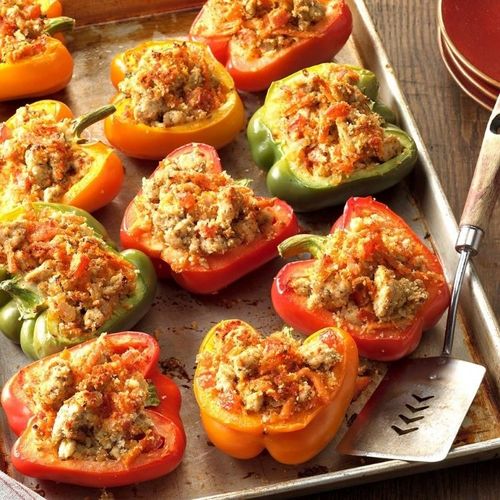Can people with diabetes eat healthfully and enjoy their meals at the same time? The answer is a resounding "yes", says Chris Smith, author of The Diabetic Chefs Year-Round Cookbook. Smith uses fresh, seasonal ingredients to create healthy, interesting meals full of flavor for individuals with diabetes and everyone else at the table, while reducing the salt, sugar and fat that many have come to rely upon to add taste.
Healthy eating...with diabetes
Just like the rest of us, people with diabetes should eat nutritious meals that are low in fat (especially saturated and trans fat), moderate in salt and very sparing in sugar, while emphasizing whole grains, vegetables and fruit . However, because people with diabetes are at a greater risk for life-threatening complications such as hypertension, heart disease and stroke, it's particularly important that they keep blood glucose control while maintaining normal levels of blood pressure and blood lipids (cholesterol). It can be challenging to do all that while still preparing flavorful and appealing food. Here The Diabetic Chef shares his secrets for preparing foods that are appropriate for people with diabetes and delicious enough for everyone.
Herbs and spices are essential
Liven up your meals with garden-fresh herbs, many of which are available year-round. Fresh herbs are densely packed with flavor. You can use herbs in a variety of ways throughout the seasons.
• Fine herbs, such as thyme, oregano, dill, basil and chives, are usually available in the spring and summer. These should be added as a finish (at the end of the cooking process) to release their delicate flavors and aromatic qualities. "Use fresh basil with summer tomatoes and olive oil for pasta, or as a finish to a tomato sauce," said Smith. "Use chives as a delicate finish to soups, salads and sauces."
• Hearty herbs (rosemary, sage), available year-round, can be added earlier on in the cooking process. Use them with stews, soups and Crock-Pot dishes. They can withstand the heat of cooking without losing flavor and, in fact, the longer they're cooked, the more mellow and flavorful they are, says Smith.
• Dried herbs must be rehydrated, so use at the beginning of the cooking process (adding as you saute onions for a sauce, for example). Your homemade tomato sauce with dried oregano and basil tastes better the next day as the flavor of the dried herbs fully blooms and combines with the other ingredients.
Herb typically describes the leaves of a plant, while spices are derived from any other part-including the root, seeds, bark or buds. Spices can be used to create a medley of flavors and can be evocative of different types of ethnic cuisines. "Spices bring great diversity to food," Smith says.
Other tips for healthful eating
Overall, Smith points out that healthful eating is a matter of practicing what he calls "Nutritional MVP," which stands for moderation, variety and portion control.
From his cookbook, another suggestion is to learn how to do template cooking. Template cooking is taking one recipe and adapting it in different ways by using the same cooking method but substituting different ingredients, says Smith. "It gives you the freedom to be creative, which is the essence of good cooking." It also brings much-needed diversity to meals, so you are not forever serving the same old thing. One example of a template recipe is the Simple Chicken Breast (see the next page). "There are only seven ingredients in this recipe but you can vary it with fresh, seasonal ingredients," says Smith. "For instance, in springtime you can exchange the olive oil for sesame oil and use lemon grass rather than garlic to create an Asian flavor. In summer, substitute fresh cilantro for the rosemary."
Try different cooking techniques to bring out the essence of foods.
Grill, broil, roast, saute or steam food to enhance flavor without added fat or salt. Slow-roast vegetables with a drizzle of olive oil in a 400-degree oven to bring out their true flavors. Many develop a natural sweetness when roasted. Season with garlic or add herbs to vary the taste. Rather than sauteing garlic or onions with butter or oil before adding them to soups or stews, try roasting in the oven.
Marinate foods in a few ingredients. "The herbs, lemon and spice in the Simple Chicken Breast recipe create a vibrant flavor, and the extra-virgin olive oil allows the herbs and spices to reach their full bouquet," said Smith.
Sear meat (brown on both sides in a pan for a few minutes before placing it in the oven) to enhance flavor without adding extra fat or salt. "Any kind and cut of meat can be seared," said Smith.
Pair dishes with colorful sides. Instead of a plate full of brown items such as chicken and rice, liven up your plate with deeply colored fruits and vegetables that add variety and important phytonutrients (components of fruits and vegetables that are thought to promote health) to your diet.
Keep the pantry stocked with these healthy ingredients.
Oils: extra-virgin olive oil, sesame oil and grapeseed oil.
Vinegars: balsamic, champagne, rice and aged sherry vinegar.
Essential spices: cayenne pepper, chili powder, cinnamon, mustard, nutmeg, paprika and pepper.
Essential dry herbs: bay leaves, dill, basil, oregano, rosemary, thyme and sage.
Other essential products: chicken, vegetable and beef broth, dried beans, whole gluten free grains such as quinoa and amaranth.
Essential fresh ingredients: lemons, limes, oranges, garlic, onions, shallots, carrots, tomatoes, potatoes, mushrooms, butter (salt free), sour cream (fat free), eggs, hard cheeses (Parmesan and Romano), mustard (grain, Dijon), capers and olives.
